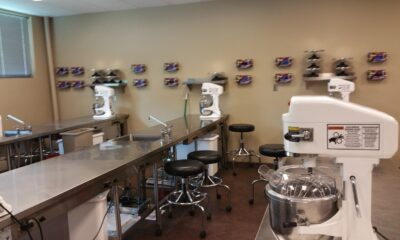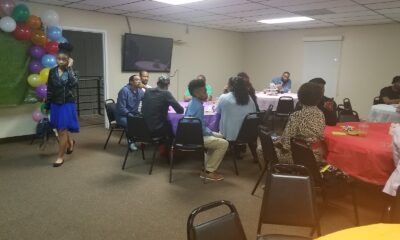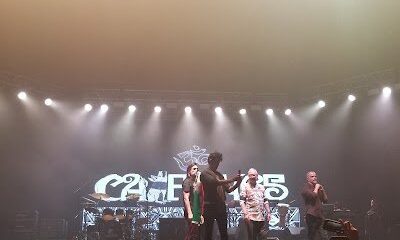News
Working With Metal Structures and Components for Events
Planning an event requires creativity, precision, and an eye for detail. No matter what type of gathering you’re planning, metal structures play a vital role in ensuring safety, functionality, and aesthetics. This guide will explore everything you need to know about working with metal structures and components for events, offering actionable insights for creating an…

Planning an event requires creativity, precision, and an eye for detail. No matter what type of gathering you’re planning, metal structures play a vital role in ensuring safety, functionality, and aesthetics.
This guide will explore everything you need to know about working with metal structures and components for events, offering actionable insights for creating an unforgettable experience.
Setting Up Stages
Stages serve as a focal point for performances, speeches, and presentations. Opting for a metal-constructed stage offers numerous advantages. These stages provide exceptional stability and can support heavier equipment, such as lighting rigs or sound systems, ensuring both performance quality and safety.
Metal stages allow for modular configurations, making it easy to customize the size and arrangement to suit your event’s unique requirements. Whether it’s a small platform for a local gathering or an expansive stage for a music festival, metal structures deliver both durability and versatility.
Designing Truss Systems
Trusses are essential for supporting lighting, sound equipment, and other stage elements, and their design needs to balance strength and adaptability. The choice of materials, typically lightweight yet durable metals such as aluminum, ensures that the system provides sufficient load-bearing capacity without being overly cumbersome.
Modular truss designs offer easy assembly and flexibility, accommodating various configurations based on the specific needs of your event. Safety is paramount, and proper weight distribution, secure connections, and compliance with industry standards are critical during the design and setup process.
Supporting Tents and Marquees
Tents and marquees are integral components for creating versatile and sheltered spaces at events. They offer protection from the elements while providing a defined area for activities such as dining, exhibitions, or performances.
Structurally, these units are supported by a combination of tensioned fabric, sturdy frames, and secure anchoring systems to ensure stability and safety. Outsourcing to professional laser cutting services will ensure they’re capable of withstanding challenging weather conditions and suit the dimensions and operational requirements of the event.
Fencing and Barriers
Fencing and barriers are designed to manage crowd flow, mark boundaries, and restrict access to specific areas. Common materials used include durable steel, aluminum, and reinforced plastics, which provide both stability and longevity.
Temporary fencing solutions can be easily assembled or dismantled, offering flexibility for various event layouts. Additionally, barriers can be customized with branding or messaging, serving both functional and promotional purposes. By incorporating reliable fencing and barriers, event planners can create a secure and well-managed environment for attendees.
Metal structures are the backbone of any successful event, offering durability, adaptability, and visual appeal. However, working with metal structures and components for events can be difficult for those without the requisite knowledge. By understanding the different options available and planning strategically, you can leave a lasting impression on your guests while keeping them safe and comfortable.
The post Working With Metal Structures and Components for Events appeared first on Event-Technology Portal.
Source: eventtechnology.org

News
Emerging Technology Trends Transforming the Event Industry
As the event industry continues to evolve, several technological advancements are reshaping how events are planned and experienced. These innovations aim to enhance engagement, streamline operations, and promote sustainability. 1. Artificial Intelligence (AI) and Machine Learning AI and machine learning are revolutionizing event planning by automating tasks such as scheduling, data analysis, and personalized recommendations.…
As the event industry continues to evolve, several technological advancements are reshaping how events are planned and experienced. These innovations aim to enhance engagement, streamline operations, and promote sustainability.
1. Artificial Intelligence (AI) and Machine Learning
AI and machine learning are revolutionizing event planning by automating tasks such as scheduling, data analysis, and personalized recommendations. AI-powered chatbots provide instant responses to attendee inquiries, improving overall efficiency and engagement.
2. Virtual and Hybrid Event Platforms
The rise of virtual and hybrid events has expanded audience reach beyond geographical limitations. Advanced platforms facilitate interactive experiences, enabling real-time networking, live polls, and Q&A sessions, thereby enhancing attendee participation.
3. Immersive Technologies: AR and VR
Augmented Reality (AR) and Virtual Reality (VR) are creating immersive event experiences. These technologies allow attendees to engage in virtual exhibitions, interactive product demos, and simulated environments, offering unique and engaging experiences.
4. Data Analytics for Personalization
Leveraging data analytics enables organizers to tailor events to individual preferences. By analyzing attendee behavior and feedback, events can be customized to enhance satisfaction and engagement, leading to more successful outcomes.
5. Sustainable Event Solutions
There is a growing emphasis on sustainability in event planning. Utilizing technology to reduce paper usage, optimize energy consumption, and manage waste contributes to eco-friendly events, aligning with global sustainability goals.
6. Enhanced Networking Opportunities
Technological advancements are facilitating better networking opportunities through AI-driven matchmaking and interactive platforms. Attendees can connect based on shared interests and goals, maximizing the value of their event participation.
7. Advanced Security Measures
Implementing robust cybersecurity protocols and utilizing technologies like facial recognition ensure the safety and integrity of events. These measures protect against data breaches and unauthorized access, maintaining trust among participants.
In summary, the integration of these emerging technologies is transforming the event industry, leading to more engaging, efficient, and sustainable events. Organizers who embrace these trends are better positioned to meet the evolving expectations of attendees and stakeholders alike.
The post Emerging Technology Trends Transforming the Event Industry appeared first on Event-Technology Portal.
Source: eventtechnology.org
News
Al Ain set to host November launch of International Hunting and Equestrian Exhibition
ADNEC Group has announced the launch of the Al Ain International Hunting and Equestrian Exhibition 2025, set to take place 26-30 November 2025 at its Al Ain centre. The five-day event is organised by ADNEC Group in collaboration with the Emirates Falconers Club. The event will feature 11 key sectors: Falconry, Camels, Equestrian, Saluki, Handicrafts,…
ADNEC Group has announced the launch of the Al Ain International Hunting and Equestrian Exhibition 2025, set to take place 26-30 November 2025 at its Al Ain centre. The five-day event is organised by ADNEC Group in collaboration with the Emirates Falconers Club.
The event will feature 11 key sectors: Falconry, Camels, Equestrian, Saluki, Handicrafts, Veterinary Equipment, Outdoor Leisure Equipment, Camping Gear, Mobile Homes, Heritage and Environmental Conservation, and Hunting and Safari Tours.
The show, organised under the patronage of His Highness Sheikh Hazza bin Zayed Al Nahyan, ruler’s representative in Al Ain Region, will include family-friendly activities such as coffee brewing competitions, traditional food contests, and various entertainment and educational features.
The inaugural exhibition will also welcome leading national and international companies and institutions specialising in hunting equipment, falconry, camel and equestrian sports, Saluki, and adventure and safari experiences from across the globe.
Humaid Matar Al Dhaheri (pictured), managing director and group CEO of ADNEC Group, stated: “The launch of this new edition in Al Ain builds upon the legacy of the Abu Dhabi International Hunting and Equestrian Exhibition, which ADNEC Group has successfully organised at ADNEC Centre Abu Dhabi for over 22 years. Al Ain was chosen as the host city for its rich cultural heritage and the significance of its market to our partners and exhibitors, particularly in outdoor sports, camping, and adventure sectors.”
He added: “The exhibition will span more than 12,000sqm, showcasing the latest innovations, equipment, and modern technologies across these key sectors. I am confident that the first edition of this event will mark a new success story in the vibrant calendar of exhibitions held in the Emirate of Abu Dhabi and the city of Al Ain.”
The post Al Ain set to host November launch of International Hunting and Equestrian Exhibition appeared first on Exhibition News | The trade for shows..
Source: exhibitionnews.uk
News
Jurassic World: The Experience to launch at Battersea Power Station
Jurassic World: The Experience is set to launch at Battersea Power Station on 23 May. The first-ever purpose-built entertainment and cultural visitor space by NEON Entertainment will stand 15 metres tall and span more than 3,200sqm of floor space. This cultural venue is set to unveil two cutting-edge shows per year, showcasing selected experiences from…

The post Jurassic World: The Experience to launch at Battersea Power Station appeared first on Exhibition News | The trade for shows..
Source: exhibitionnews.uk
-
venue2 days ago
Dulles Expo Center
-

 venue2 days ago
venue2 days agoHospitality Resort Management Center
-

 venue2 days ago
venue2 days agoForest Hill Civic & Convention Center
-

 venue2 days ago
venue2 days agoThe New York Expo Center
-

 venue2 days ago
venue2 days agoJackson Convention Complex Center
-
venue2 days ago
Duluth Energy Design Conference & Expo
-
Perspectives7 days ago
Design a perfect home
-

 venue2 days ago
venue2 days agoFord Wyoming Center




You must be logged in to post a comment Login